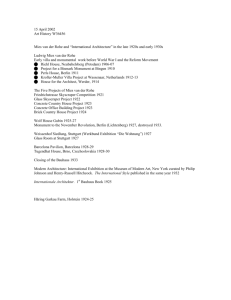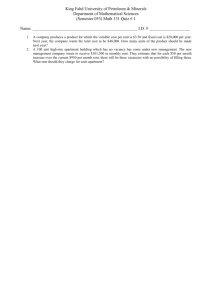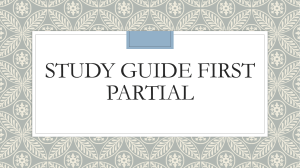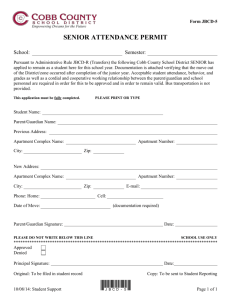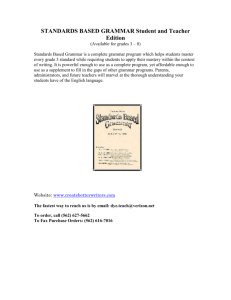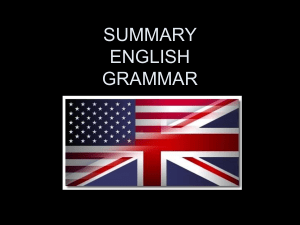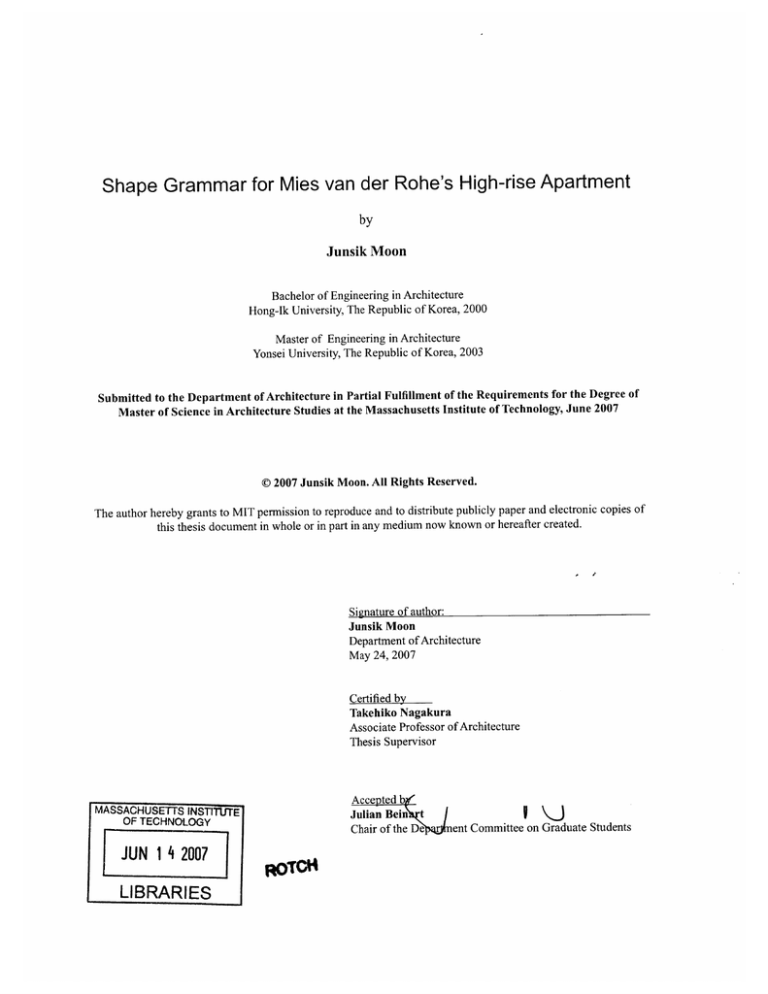
Shape Grammar for Mies van der Rohe's High-rise Apartment
by
Junsik Moon
Bachelor of Engineering in Architecture
Hong-Ik University, The Republic of Korea, 2000
Master of Engineering in Architecture
Yonsei University, The Republic of Korea, 2003
Submitted to the Department of Architecture in Partial Fulfillment of the Requirements for the Degree of
Master of Science in Architecture Studies at the Massachusetts Institute of Technology, June 2007
@2007 Junsik Moon. All Rights Reserved.
The author hereby grants to MIT permission to reproduce and to distribute publicly paper and electronic copies of
this thesis document in whole or in part in any medium now known or hereafter created.
Signature of author:
Junsik Moon
Department of Architecture
May 24, 2007
Certified by
Takehiko Nagakura
Associate Professor of Architecture
Thesis Supervisor
A cce ted b
MASSACHUSETTS INSliTUTE
OF TECHNOLOGY
JUN 14 2007
LIBRARIES
Julian Bein Dt
Chair of the De
jTCH
I o
J
ent Committee on Graduate Students
Shape Grammar for Mies van der Rohe's High-rise Apartment
By
JunSik Moon
Submitted to the Department of Architecture on May 24, 2007 in
Partial Fulfillment of the Requirements for the Degree of
Master of Science in Architecture Studies
ABSTRACT
This thesis explores an application of a rule-based method to a practical architecture design. It uses shape grammar, a paradigm of generating designs in a specific style by using
shape tokens (architectural elements) and rules of transforming between them. If a shape
grammar can be made for mass production design that needs many repetitious units with
slight differences, it would be very productive and valuable in the context of professional
architectural practice.
As an example, this thesis proposes a shape grammar for generating apartment plans in
the style of Mies van der Rohe's high-rise projects that he made in the first half of twentieth century. Through this grammar, alternative apartment plans with different volumetric
schemes can be developed rapidly for the given site, and allow an architect to quickly
evaluate different possibilities of a building's mass and layout. Such a grammar also can
be a good pedagogical tool, and an architectural student can use it to study and understand
Mies van der Rohe's apartment designs.
The thesis evaluates the advantages and the disadvantages of this shape grammar in the
context of professional practice, and discusses the possibilities of similar grammars that
could be developed for other architectural styles.
Thesis Supervisor: Takehiko Nagakura
Title: Associate Professor of Design and Computation
2 150
Acknowledgements
I am deeply thankful to my advisors Takehiko Nagakura, George Stiny, and William J.
Mitchell for their friendship, support, and guidance. They taught me new ways of looking
at design. My thesis owes to their works on shape grammars.
I also thank Prof. Terry Knight for encouragement and generosity in sharing her vast knowledge for shape grammar.
My thanks also go to my friends:
Kirin-i for proof reading my thesis, Jiwoon Kim and Kyuri Kim for easily discussions.
I dedicate this thesis to GOD, my parents and my younger brother.
The readers of this thesis are:
Georgy Stiny
Professor of ArchitCcture
William Mitchell
Professor of Program in Media Arts and Sciences
3 150
Table of Contents
A b stract..........................................................................................2
A cknow ledgem ents..............................................................................3
5
1. Introduction ..................................................................................
1.1 Preview: problem and solution.....................................................5
1.2 Organization of Thesis..........................................................7
1.3 Back Ground Knowledge
1.3.1 Shape Grammar.................................................9
1.3.2 Mies Van der Rohe Housing Projects.........................9
20
2. Shape Grammar of Mies Van Der Rohe's Apartment Plans..............................
2.1 Analyses of Mies Van Der Rohe's Apartment Plans.......................20
2.2 Shape Grammar for Mies Van Der Rohe's Apartment Plans................22
2.3 Derivation of an Existing Design .............................................
40
3. Evaluation and Conclusion...................................................................45
4. B ibliography ................................................................................
49
5. Im age C redits................................................................................
50
4 150
Shape Grammar For Mies van der Rohe's High-rise Apartment
1. INTRODUCTION
1.1 Preview: problem and solution
Shape grammar is a method of generating designs by using primitive shapes and the rules
of interaction between them. Shape Grammars usually have an IF-THEN structure and involve two steps: Recognition of a particular shape -- i.e. IF a certain shape is found -- and
transformation or replacement of the shape -- i.e. THEN apply certain rule to it. As a simple
example, one rule is that if there is a rectangle, subdivide it into two rectangles. This rule
can also then be applied to each new rectangle.
George Stiny and James Gips introduced Shape Grammars in the early 1970s as a way of
describing and creating paintings and sculptures. Over time, shape grammars have been
widely used to recreate the works of various artists like Piet Mondrian, Georges Vantongerloo and Fritz Glarner. Surprisingly, these grammars were able to recreate many of the artworks with a great degree of accuracy. Shape grammars have been used in the architectural
field to develop designs such as Palladian villas (Stiny and Mitchell 1978), and Prairie
houses (Koning and Eizenburg 1981). However, the use of shape grammars is not limited
to the architectural field. It has also been used for designs such as window lattice designs
in the Iceray grammar (Stiny 1977), Froebel block arrangements in the Kindergarten grammar (Stiny 1980), and coffee makers in the Coffee maker grammar (Agarwal and Cagan
1998). Each grammar generates a design by using a particular technique of the shape grammar language. Shape grammars were even tried to be used for collaborating design and for
design education.
The inventors of shape grammars showed that existing designs can be analyzed and the
logics behind them can be identified in terms of simple grammatical shape rules. These
shape rules, once extracted, capture the visual style of the original design. Hence, shape
grammars can be thought of as a way of encapsulating styles. The understandings of relationships of shapes can explain and deconstruct design processes which might be difficult
to explain otherwise. Moreover, the construction of rules has pedagogical a value in the
sense that it can help understand the principles behind the design. Furthermore, since shape
grammar is about defining spatial relationships, they can be applied to architecture. For
instance, Durand, the eighteenth century architectural educator, demonstrates how shape
grammar can be used to define spatial relationships to generate architectural floor plans.
His grammar divides architectural elements into basic spaces such as porches, entrances,
stairs, rooms and courtyards. There are rules for the placement of each space. Through the
rules, he shows how different spaces can be combined together to generate floor plans.
Even though studies applying shape grammars to various architecture fields began a few
decades ago, its adaptation has not been practically successful. Two reasons could be given
for this failure.
5 150
Shape Grammar for Mies van der Rohe's High-rise Apartment
First, the process of shape grammar is not familiar to most architects, who follow traditional design processes to generate design alternatives from concepts or from site analyses
of context and environments and for whom shape grammar may seem too mathematical in
nature.
Second, even though the productivity and practical potential of shape grammar are very
high, there have been few studies of how to apply it practically.
The final goal of this work is making a shape grammar for generating the mass apartment
plans that include designers' fundamental concepts and high-quality design. The purposes
of the application are twofold. First, it provides high-quality plans in order to enable designers to save time and to provide more opportunities to apply various alternatives for the
designs of diverse volumes and site plans. High quality design of apartment plans can be
qualified by using Mies Van Der Rohe's apartment plans he participated in many numbers
of apartment projects. Second, the analyses of most of his apartment plans are meaningful
in letting people understand his design style and using for practical purpose. The current
foci are on the development of the design process and the practical application of shape
grammars.
6|50
Shape Grammar for Mies van der Rohe's High-rite Apartment
1.2 Organization of Thesis
This thesis is organized into six chapters including this introductory chapter. Figure 1.1
shows the flow of organization of this thesis.
(Collection
of Mies High-Rise Apartment Resources
Analyses of Collected Projects Plans
' I''""""
Mullion Modules
Column Modules
U
8698,
1
Nm..,
UnitTypes
CorridorTypes;
CoreTypes
Ue
C~aking
AShape
Grmmar
thrugthReusofheAay!
Evaluation of the Shape Grammar
U
U
U
U
U
U
U
U
U
S
S
S
S
S
S
S
S
S
S
~ations
S
~sons
S
S
S
0
S
S
S
S
S
~Analysis~
U
U
U
U
U
U
U
U
U
Conclusiohn
e
Figure 1.1 Flow Diagram of Thesis
7 50
Shape Grammar for mies van der Rohe', High-rise ipartment
Mies' thirty high-rise apartment plans and two low-rise apartment projects are collected for
studying and analyzing. The grid system, his design's fundamental factor, affects the whole
design process from column to mullion in detail. In order to find it, column and mullion
modules are studied and analyzed.
By using the modules and the results of analyzing of collected plans, possible core systems,
corridor types and unit types are categorized for making a shape grammar. The generated
shape grammar can be evaluated by generating original Mies' plans through derivations.
Through this process, the possibilities how a shape grammar will apply into a practical architectural field will be mentioned. At the same time, the limitations and difficulties of the
grammar will be dealt with.
8 150
Shape Grammar For Wiet van der Rohe', High-re Apartment
1.3 Background Knowledge
1.3.1 Shape Grammars
Shape grammar is a general computational language that manipulates shapes to generate
designs. It has been used in the architectural field to develop designs such as Palladian
villas (Stiny and Mitchell 1978), Prairie houses (Koning and Eizenburg 1981), and even
Chinese government buildings based on the Yingzao Fashi book (Li 2001). But the use of
shape grammars is not limited to the architectural field. It has also been used for designs
such as window lattice designs in the Iceray grammar (Stiny 1977), Froebel block arrangements in the Kindergarten grammar (Stiny 1980), and coffee makers in the Coffee maker
grammar (Agarwal and Cagan 1998). Each grammar generates a design by using a particular technique of the shape grammar language.
For the Iceray grammar, a sub-division technique is used to generate the design. Each polygon is divided to create more polygons which recursively gets divided. The Kindergarten
grammar uses labeled points to generate distinctive arrangements of Froebel blocks. The
labeled points use the symmetry of the blocks to control how the blocks can be assembled.
The Yingzao Fashi grammar uses parallelism as its technique for generating a design. The
parallel descriptions allow the design of the section and elevation to be in correspondence
with the floor plan.
Shape grammar applies if-then rules composed of schemata to affect changes in a design.
A grammar expresses the process of design through a series of schema rules. The rules are
used to convey the design transformations used by the designer. A problem occurs when the
designer can not express his design transformation in a rule explicitly and concisely with
the shape grammar language. Although shape grammars can produce the resultant design,
the manner in which that design is produced may not be the same. To resolve this problem,
there are two choices. Either alter the designer's process to fit within the descriptive means
of shape grammars or define new descriptors to alter shape grammars to accommodate the
designer's process.
1.3.2 Mies van der Rohe High-Rise Apartment Projects
A prominent architect, Ludwig Mies van der Rohe is known as one of the masters of modern architects. He clearly established his new architectural style extreme simplicity and
clarity. He also made an effort to adapt new materials such as industrial steel and glass
plate. Especially in his high-rise apartment projects, he purely exposed steel structure and
glass without any decoration. He referred to his buildings as "skin and bones" architecture
. Mies' egalitarian design affected by Peter Behrens, an industrial designer and architect,
can be expressed well through the various apartment projects. In this chapter, 32 apartment
projects used for analyzing and making a shape grammar will be listed with typical plans
and a couple of pictures for each project.
9150
Shape Grammar for
nies van der Rohe's High-rise Apartment
Weissenhofsiedlung, 1925-1927
Houses and apartment buildings. A housing colony on a hill
overlooking Stuttgart, Germany. These twenty-one houses
and apartment buildings project comprise one of the most
celebrated communal endeavors in the history of modem architecture. The ultimate success of this project was the role
played by its artistic director, Mies himself, whose strategy
was to invite a group of the most famous European architects
to design individual buildings in conformity with the plan
that he had designed himself.
Nil
'VP'*lI~
V)'
'
'
w
~
(2)
Reich Apartments in the Boarding House
The two apartments that Lilly
Reich designed for the Boarding
House were meant for a single
person and a childless couple,
respectively. The smaller suite
occupied two bays; the larger,
three.
(4)
(3)
Mies Apartment for a Bachelor, 1931
This project was designed for bachelors at Berlin Building
Exposition. Within a space slightly less than seven by nine
meters he provided a living area which included furnishings he designed such as the MR chair and the 193 1Lounge
chair.
(5)
10150
Shape Grammar tor fnies van der Rohe's High-rise Apartment
Lohan Apartment, 1937
Apartment furnishing and decoration. It was for his second-born daughter Marianne and her husband, the Gymnasium professor Wolfgang Lohan. It was located in the
Berlin suburb of Rathenow, Germany.
(6)
Promontory Apartments, 1946-1949
Apartment building. Located on 5530 South Shore Drive,
Chicago, IL, USA. It was the initial product of the relationship Mies struck up with the Chicago developer Herbert Greenwald. This collaboration yielded over a dozen
major buildings and complexes.
(8)
(7)
Algonquin Apartments, 1948-1951
Apartment building. Cornell Avenue at East
Fiftieth Place and East End Avenue near
Hyde Park Boulevard, Chicago, IL, USA.
(9)
(10)
11 50
Shape Grammar for iliet van der Rohe's High-rite Apartment
860-880 Lake Shore Drive Apartments, 1948-1951
Apartment buildings. A pair of twenty-six-story towers at
860/ 880 Lake Shore Drive, along the City's Gold Coast of
Chicago, IL, USA. Extending from Chestnut Street north
one block to Delaware Street with a view to Lake Michigan
across the drive. For this assignment Mies was able to return
to the steel frame that the post-war steel shortage had prevent him from using in previous project.
LL
01-0
(11)
(12)
Charles B. Genther Apartment, 1951-1952
Apartment interior design. An Apartment in the south corner
of the top floor (26th) of Mies's 860 Lake Shore Drive building, Chicago, IL, USA.
Herbert Greenwald Apartment, 1951-1953
Apartment interior design. 860 Lake Shore Drive, Apartment 25M, Chicago, IL, USA. It was built in the penthouse
of Mies's Commonwealth Promenade Apartment Building
Berke Apartments, 1952-1953
Unbuilt project. Schematic studies of apartment buildings.
Possible location was on Thirty-sixth and Meridian Streets,
Indianapolis, IN, USA.
(13)
(14
121 50
Shape Grommer for Mies Von der Rohes Iligh-rise Apartment
Esplanade Apartment Buildings, 1953-1956
Apartment buildings. 900-910 Lake Shore Drive, Chicago,
IL, USA. After the success of the 860/880 Lake Shore Drive
Apartments, together, Mies and Greenwald conceived five
major project proposals on Chicago North Side. Esplanade
was one of them.
(15)
(16)
1300 Lake Shore Drive Apartments, 1953-1956
Unbuilt project. Two apartment buildings. 1300 Lake Shore
Drive, Chicago, IL, USA. The project was one of the five
proposals conceived by Mies and Greenwald together on
Chicago North Side.
Commonwealth Promenade Apartments, 1953-1956
Four Apartment building located at the corner of Diversey
and Sheridan Road, Chicago, IL, USA. The project was one
of the five proposals conceived by Mies and Greenwald together on Chicago North Side.
(17)
(18)
13 150
Shape Grammar for fnies van der Rohe's High-rise Apartment
Internationale Bauausstellung, 1954-1956
Unbuilt project. Expo. Interbau Housing Exposition was
staged in Berlin, Germany in 1957. among the contributors to the event were Le Corbusier, Walter Gropius, Alvar
Aalto, Wassily Luckhardt and Hans Schwippert. Mies, who
was invited to participate in the show, never completed the
project he began.
(19)
Lafayette Park, 1955-1963
Park development including town houses and 21 -story
apartments. Lafayette Park, Detroit, MI, USA. This project
brought together Mies and Ludwig Hilberseimer in their first
and only completed professional collaboration with the participation of the landscape architect Alfred Caldwell.
(20)
(22)
(21)
Diversey-Lake Shore Drive Apartments, 1956-1958
Unbuilt project. Apartment buildings. Between two and six
buildings to be on West Diversey Parkway and Lake Shore
Drive, Chicago, IL, USA. The project was one of the five
proposals conceived by Mies and Greenwald together on
Chicago North Side.
14150
Shape Grammar for
nies van der Rohe's High-rise Apartment
Battery Park Apartments, 1957
Unbuilt project. Apartment building. Battery Park, New
York, NY, USA. The proposed parcels of land flanked Broad
Street between Water and South Street.
(24)
Quadrangle Apartments, 1957-1959
Unbuilt project. Apartment buildings. Dekalb Avenue between Saint James Place and Classon Avenue, Brooklyn, NY,
USA. The Quadrangle Apartments were four 19-story buildings intended as housing for Pratt Institute in Brooklyn.
(23)
(25)
Rimpau Apartments, 1958
Unbuilt project. Two apartment buildings with a one story
shopping unit and a motel added at the west end. Rimpau
Boulevard and Eighth Street, Los Angeles, CA, USA.
(26)
15 50
Shape Grammar for
nies van der Rohe's High-rise Apartment
Brookfarm Apartments, 1959
Unbuilt project. A composition of two 20-story apartment
buildings separated by large plaza. Brookline, MA, USA.
(27)
Hyde Park Urban Renewal, 1959
Unbuilt project. Urban project. Possible location was in
Hyde Park near University of Chicago, Chicago, IL, USA.
H. Greenwald with Mies proposed it in collaboration with
Ludwig Hilberseimer in various scattered parcels of land in
the vicinity of the university.
(28)
Lafayette Towers, 1960
Two apartment buildings with a garage standing on the opposite or east side of the Lafayette Park near the intersection
of Orleans and Lafayette streets, Detroit, MI, USA.
(29)
16150
Shape Giammar lot Uies van der Rohe's High-rise Apartment
Mountain Place Development, 1961
Unbuilt project. Possible location was on a sloped site between Rue de la Montagne and Rue Drummond in Montreal,
Quebec, Canada. Two buildings rest on a platform, one is a
43-story apartment structure and the other is about 14-stories
presumably for offices.
(30)
2400 Lakeview Apartments, 19621963
Apartment building. It is located beyond Lincoln Park facing Lakeview
at 2400 Lakeview Drive, Chicago,
IL, USA.
(32)
Highfield House Apartments, 1962
14-story apartment building. It is located at 4000 North
Charles Street, Baltimore, MD, USA. It is built on a frame
of reinforced concrete with a skin that is an infill, both fixed
and openable windows.
(33)
(34)
17| 50
Shape Grammar for
nies von der Rohe's High-rise Apartment
Church Street Development, 1965
Unbuilt project. Street Redevelopment and Renewal Project
was top be in New Haven, CT, USA. The project included
Housing for the Elderly; Public Family Housing, Moderate
Income Housing; Upper Middle Income Housing; and Primary School.
(35)
(36)
Foster City Apartments, 1964
Unbuilt project. Apartment buildings. Two 21-story highrise blocks rising from a platform base are separated by a
wide terrace on which a single-story restaurant/recreation
building is located. The proposed location was in San Mateo, CA, USA.
(37)
Promontory Addition, 1965-1968
Unbuilt project. Supervising an assortment of additions to
the Promontory Apartments building that were designed
by Mies and located on 5530 South Shore Drive, Chicago,
IL, USA. Two decades after the completion of Promontory,
Mies was asked to supervise an assortment of additions to
the original building.
(38)
18 50
M
Shape Grammar for flies van der Rohe's High-rise Apartment
(39)
General Housing, 1951-1955
Apartment complex. The lIT apartment of three buildings (Carman Hall, Bailey hall, and Cunningham Hall)
occupies the northeast sector of the campus. A fourth
apartment building in the same grouping was executed
by another architect. All of them are located between
31st Street and the south side of 32nd Street. These
buildings were intended to accommodate staff, faculty,
and married students.
Carman Hall Apartments, 1951-1953
60 East 32nd Street
Bailey Hall Apartments, 1952-1955
3101 South Wabash Street
Cunningham Hall Apartments, 1952-1953
3100 South Michigan Avenue.
(40)
19 | 50
Shape Grammar ot iies van der Rohe's High-rise Aparment
2. Shape Grammarfor Mies van der Rohe's High-rise Apartment Plans
2.1 Analyses of Mies van der Rohe's Apartment Plans
Mies' many high-rise building designs show us his rational design approach and process.
This design feature was affected by one of Bauhaus principles that states, "the design is
efficient and functional". In this chapter, 32 projects will be analyzed and examined for
making the high-rise Shape Grammar. The features of each project such as module systems
and core types will be mainly dealt with. Because many cases of non-famous project plans
have poor-quality in terms of accuracy for measurement, written numbers related to measurements are not exact numbers, but approximate numbers.
The modules of column and mullion were used as fundamental resources for making important rules to generate original Mies style grids and details.
The most fundamental factors for generating plans are the definition and the categorization
of core types and unit types. Figure 2.1 shows the categorization of core types and organization of Mies' projects embraced in each category. In the Hyde Park Renewal Project's
case, even though the core type is for low-rise apartments, it still has high-possibilities to
be applied to high-rise apartment plans with a few shape tokens of high-rise. Thus, in this
thesis, the last core type is added to give more variety. Specially, Internationale Bauausstellung Berlin Project has two core types, center corridor type and center core type, at the
same time.
Center Corridor
Promontory Core 03
Center Core
Promontory Core 01
Promontory Core 04
Promontory Core 02
Low-Rise
.............. !
Figure 2.1 Core Types
20150
Shape Grammar lor ies van der Rohe's High-rise Apartment
Core Types
Projects
Typical Plan
Mountain Place Development, Highfield
House, Quadrangle Apt, Rimpau boulevard
and Eighth Street, Carman Hall Apt, Bailey
Hall Apt, Cunningham Hall Apt, 860/880
Lake Shore Drive, West Diversey Parkway
and Lake Shore Drive, Brookfarm Apt, Battery Park Apt, Berke Apt, Pavilion Apt, Internationale Bauausstellung Berlin, Foster
City Apt, Esplanade Apt
2400 Lakeview Drive, Church Street Redevelopment and Renewal Project, Housing for the Elderly, Public Family Housing,
Moderate Income Housing, Upper Middle
Income Housing, Algonquin Apt, Internationale Bauausstellung Berlin
Promontory Apartment
LI
Promontory Apartment
_
_
Promontory Apartment
Promontory Apartment
Hyde Park Project, Town House
21 50
Shape Grammar for fines van der Rohe's High-rise Apartment
The red colored shape is transformed into a core area including corridors. The black area
represents space for a unit of an apartment.
Each type has many alternative unit plans designed by Mies. This fact allows the grammar to generate affluent alternatives of an apartment plan. The following Figure 2.2 shows
some instances of diverse unit types. There are few abridged unit types since many unit
types have just trivial differences.
L-Shape
Rectangle Shape
Square Shape
Irregural Shape
C L
Figure 2.2 Diverse Unit Plan types
2.2 Shape Grammar for Mies Van Der Rohe's Apartment Plans
The grammar derives plans in a top-down fashion, working from the module-grids of plans
to columns, cores, corridors, walls, units and details. Derivations are organized into eight
main stages, as follows:
1. grid definition
2. column: I-shape steel
3. core
4. corridor
5. unit shape
6. unit plan
7. detail: windows, mullions, doors, and furniture
8. termination
In order to make sufficient shape grammar that can generate various types of apartment
plans from Mies twenty-four apartment projects, the shape grammar has to have several
22150
Shape Grammae for Mies vn der Rohe's High-rise Apatment
rules. The following figures show the shape grammar rules.
Stage one is for making a grid system which is the basic structural module of a building. As
a default, the distance of a grid is based on modules examined through the analyses of his
works. In stagel, the size of building and the size of unit are determined by the module.
Stage I
e
--------
-+
--
--
+
---
-
-- 12
4 ----
+
0(0,0)
--
-+ --
- -
---
(Default W = H)
Rule 1
Rule2
D
I
I
Rule 3
Rule 4I
Rule 5:
0(0,0)
23150
Shape Grammar for Uier van der Rohe's High-re Apartment
Stage I
Rule 7
Rule 8
A
--
0
Termination
Rule 9
Stage 2
W
+ 11
Rule 10
Rule 11I
A
Rule 12
24150
Shape Grammar for Mies van der Rohe's High-rise A1partment
In stage two, columns and exterior walls are generated. The intersection points of the grid
lines transform into columns. All Mies' high-rise projects have common rules until stage
two. There is a divergence starting from stage three for making a decision core type. It allows us to select one of seven core types mentioned above. The result of stage three allows
a decision to be made for a possible corridor type. There are some cases where there are no
corridors. After the selection of a core type, corridor types are determined in stage four. If
a corridor does not exist in this state, this stage should be ignored. The decision of corridor
types depends on the end shapes of corridor. It affects the decision of rules for unit plan
types. In stage five, diverse unit shapes are determined by rules. The categorization of each
unit shape is based on the size by the number of columns.
Basically, unit shapes are rectangle shapes generated by the grid. However, the shapes of
corridor types and core elements transform original shapes into various shapes. Four types
classify these: L-shape, rectangle, square, and irregular shapes. Each of the unit shapes
transforms into one of the various unit plan types Mies designed in stage six. Detailed elements including doors and windows are dealt with in stage seven. In stage eight, there are
termination rules to remove unnecessary lines and marks.
25150
Shape Grammar Wor Uies van der Rohe's High-rise Apartment
Stage 2
Rule 13
Stage 5
D
C.E
LIll
C.E
C.E
C.E
I
k
C.E C.E
-C.E
(C.E= Core Elements)
Rule 15
Rule 14
LI
C.E
D
---W
.-
(C.E= Core Elements:
Rule 16
Rule 17
Rule 19
Rule 20
Rule 18
Rule 21
r-
C.E
Rule 22
CE
-- I
Rule 25
Rule 24
Rule 23
C.E
| -- +
Rule 26
26150
Shape Grammar for Mies van der Rohe's High-re Apartment
Stage 5
IC.E-+
|| |
C.E
C.E
Rule 29
-+EE
1C.E
Rule 30
C.E
Rule 31
-+1 ai
1C.E
Rule 32
0
C.E
Rule 34
Rule 33
E
IzwIzhd
C.E-1
Rule 36
Rule 35
-+
[=MII
C.E
-+
UT
Rule 38
Rule 37
hIMM
Rule 39
-+
Rule 28
Rule 27
C.EI
C.E
C.E
Rule 40
27 I 50
Shape Grammar for lies van der Rohe's High-rise Apartment
Stage 4
c~
I
I1Eh
--
Rule 42
Rule 41
LEl
EI--K|L
E
Rule 45
4
L
F5
Z-+
L2L1
I] H
Rule 47
Rule 46
.
Rule 49
F-i
Rule 44
Rule 43
Rule 50
Ru le 48
L _
Ru]le 51
Rule 52
28150
Shape Grammar for Mies van der Rohe's High-rie Apartment
Stage 5
Rule 54
Rule 53
Rule 55
1
10
Rule 56
Rule 57
Rule 58
29| 50
Shape Grammar or Mies von der Rohe's High-rise Apartment
Stage 5
Rule 59
Rule 60
Rule 61
30150
Shape Grammar for Mies van der Rohe's High-re Apartment
Stage 6
0
Rule 62
Rule 64
Rule 66
Rule 68
Rule 63
Rule 65
Rule 67
Rule 69
311 50
Shape Geommat lot Mies van det Rohe'i High-tise Apatment
Stage 6
Rule 70
i
Rule 71
Rule 72
Rule 73
Rule 74
Rule 75
I~L
Rule 76
Rule 77
32 50
Shape Grammar tor lies van der Rohe's High-rise Apartment
Stage 6
LJRule 78
Rule 79
Rule 80
Rule 81
Rule 82
Rule 83
Rule 84
33150
Shape Grammar for lie van der Rohe's High-rise Apartment
Stage 6
Rule 85
Rule 86
Rule 87
Rule 88
34150
Shape Grammar for lies van der Rohe's High-tre Apartment
Stage 6
IT
Rule 89
0
Rule 90
Rule 91
R 9l
Rule 92
Rule 93
T1
Rule 94
Rule 95
35150
Shape Grommar for lies van der Rohe's High-rise Apartment
Stage 6
K
A~
Rule 97
Rule 96
Rule 98
Rule 99
36 50
Shape Grammar for llies van der Rohe's High-rise Apartment
Stage 6
Rule 100
Rule 101
Rule 102
Rule 103
371 50
Shape Grammar for
ies van der Rohe's High-tise Apattment
Stage 6
Rule 104
Rule 105
I
0
Rule 106
r1
Rule 107
38 50
Shape Grammar for Mies van der Rohe's High-rie Apartment
Stage 7
Rule 108
Rule 110
Rule 109
Rule 111
Stage 8
Rule 112
Rule 113
Rule 114
Figure 2.3 The rules for generating Meis' high rise apartment plans
39 50
Shape Grammar for lies van der Rohe's High-rise Apartment
2.3 Derivation of an Existing Design
In this chapter, an example of derivation will be shown by using Mies van der Rohe highrise shape grammar shown in the last chapter.
Stage 1
.............................................................................................................
I
--- -
-
-
--
-
-
-
-
-
-
0(0,0)
(Default W = H)
Rule 2
Rule 1
Rule one is a rule to generate a core and to decide of the size of it. W and H represent width
and height of the core respectively. At the same time, those numbers automatically are assigned to the module size of the grid system. These numbers can be adjusted by users.
........................................
hi
A
------
Rule 1
Rule 6
------------------
Rule 2
Rule 6 should be also applied to the horizontal line, too. Figure 2.4 is one possible example of various grid module systems.
40150
Shape Grommer fot flies va der Rohe's High-rise Apartment
A
Figure 2.4 The Grid generated For 860/880 Apartment Plan
Stage 2
W
A
A
Rule 11
Rule 12
___
__P__
___
v
Figure 2.5 Columns and Exterior Walls For 860/880 Apartment Plan
411 50
Shape Grammar for
--
C.E
L.C
C.E
P
niet von der Robes High-rise Apartment
C.E
C.EE
ff.ElC.E
(C.E= Core Elements)
(LC = Long Corridor)
Rule 26
Rule 41
Rule 16
L
.
~
I-
W
JM
iff
Ir
.14
OiO .
Figure 2.6 Core Types and Core Elements generated by rules 10, 11, 16
E-
Rule 53
E
E
E
Rule 54
42 50
Shape Grommar for lies van der Rohe's High-rise Apartment
Rule 57
If-
...........................
L.....
r-1
[~J
I
-~
Rule 48
Rule 46
Rule 45
............................................................................................................................
m
M.
to
W0
I
m IN
Pff
I-
II
U
6
-
*
I
I-
I
I-
-'l
U-
Figure 2.7 Units Types and End Parts oftCorridor generated by Rules 10, 11, 16
431 50
Shape Grammar for lies van der Rohe's High-rise Apartment
Buy...
D.........
Rule 66
Rule 62
o Termination
Rule 108
Rule 112
Rule 114
44 50
Shape Grammar for Mlies van der Rohe's High-rite Apartment
Figure 2.8 Typical plan of 860/880 Lake View Project generated by rules
3. Evaluation & Conclusion
This thesis explores the application of Shape Grammar to a practical architecture design.
Shape Grammar that can generate various design results by using shape tokens and simple
rules of transforming can be extremely optimized for mass production design like high-rise
apartment designs. As a possibility, this thesis suggests a shape grammar for generating
apartment plans in the style of Mies van der Rohe's high-rise projects.
In order to make the shape grammar, his twenty-four high-rise apartment plans were studied and analyzed. As a result, the common methodologies, possible to be his topologies,
were found. It allowed the author to make rules for generating Mies van der Rohe's highrise apartment. This Shape Grammar could generate various original Mies' apartment plans
such as the 860/880 Lake Shore Drive apartment and the 2400 Lakeview apartment.
The shape grammar sometimes showed interesting results. The rules to make diverse core
types generated unexpected Mies style plans which have several core types at the same
time. Moreover, unit plan types categorized by shapes could generate a myriad of different
types of plans. These can be used as a valuable resource for architecture students to help
them understand Mies design styles and apartment plan designs as a design reference. Figure 3.1 and 3.2 show examples of Mies' original plans that were generated by Mies shape
grammar. Figure 3.3 shows an example of Mies' style plan generated by the grammar.
45150
Shape Grammar for Mies van der Rohe's High-rise Apartment
Figure 3.1 Mies' 860/880 Lake Shore Drive Apartment Plan generated by the Shape Grammar
Figure 3.2 Mies' 2400 Lake View Apartment Plan generated by the Shape Grammar
461 50
Shape Graomar for lies van der Rohe's High-rie Apartment
Figure 3.3 APlan of Mies Style generated by Shape Grammar
However, too many apartment plans were collected which made it hard to make a shape
grammar which could satisfy all types of plans. Especially, the unique unit type plans had
many indented parts which were difficult to transform with other plans. See Figure 3.1.2.
Nonetheless, each unique type could be used a role as a rule that could generate more diverse apartment plans through various combinations.
Figure 3.4 Examples of Indented Parts
Through this grammar, alternative apartment plans with different volumetric schemes can
be developed rapidly for the given site, and allow an architect to quickly evaluate different
possibilities of a building's mass and layout. Such a grammar also can be a good pedagogical tool, and an architectural student can use it to study and understand Mies van der Rohe's
apartment designs. The thesis evaluates the advantages and the disadvantages of this shape
grammar in the context of professional practice, and discusses the possibilities of similar
grammars that could be developed for other architectural styles.
47 50
Shape Grammar for Mies van der Rohe's High-rite Apartment
For further study, the possibility of a computer-based application that applies the grammar
discussed in this thesis to architectural practice can be looked at. This application will be
able to generate plans quickly and limitlessly, as well as execute each rule by going back
and forth through a sequence. The application may save time in the design process by doing repetitive works. If this computer based application can be interlocked with Auto CAD
program, it can also provide user-friendly interface for architects, not familiar with shape
grammar, to use the shape grammar. If some conditions such as regulations or environmental factors can be applied to the application, it will be able to evaluate the generated plans.
48150
4. Bibliography
1. Abigail Harrison-Moore & Dorothy Rowe: 2006, "Architecture and design in Europe
and America, 1750-2000", Malden, MA: Blackwell.
2. Jos6 Pinto Duarte, Customizing mass housing: a discursive grammar for Siza's Malagueira houses.
3. Nagakura T: 1995, Form-processing: A System for Architectural Design, PhD Dissertation, Harvard University, Cambridge, Massachusetts.
4. Mitchell W: 1990, The Logic of Architecture, MIT Press, Cambridge, Massachusetts.
5. Mies van der Rohe, Ludwig, 1886-1969, Catalogues raisonnes
6. Posner M: 1980, "Orienting of attention" Quarterly Journal of Experimental Psychology
32: 3-25.
7. Rowe C: 1976, The Mathematics of the Ideal Villa and Other Essays, MIT Press, Cambridge, Massachusetts.
8. Rykwert J, Leach N, Tavemor R: 1988, On the Art of Building in Ten Books, MIT
Press,
9. Sch6n D: 1983, The Reflective Practitioner: How Professionals Think in Action, Basic
Books, New York.
10. Sch6n D, Wiggins G: 1992, "Kinds of Seeing and Their Functions in Designing" Design Study 13(2): 135-156.
11. Stiny G: 1977, "Ice ray: a note on the generation of Chinese lattice designs" Environmental and Planning B 4: 89-98.
12. Stiny G: 1980a, "Introduction to shape and shape grammars" Environmental and Planning B 7: 343-35 1.
13. Stiny G: 1980b, "Kindergarten grammars: designing with Froebel's building gifts"
Environmental and Planning B 7: 409-462.
14. Stiny G: 1981, "A note on the description of designs" Environmental and Planning B
8:257-267.
49150
Shape Grammar For Mies van der Rohe's High-rie Apartment
15. Stiny G: 2001, "How to calculate with shapes" (working paper), MIT Department of
Architecture.
16. Stiny G, Mitchell W: 1978, "The Palladian Grammar" Environmental and Planning B
5:5-18.
17. Tzonis A, Lefaivre L: 1986, Classical Architecture: The Poetics of Order, MIT Press,
Cambridge, Massachusetts.
5. Image Credits
(1) http://www.mortsel.be/.../ 1332.jpg&x=150&y=125
(2), (3), (4), (5), (6), (7), (8), (9), (10), (12), (13), (14), (16), (18), (19), (22), (23), (24),
(25), (26), (27), (28), (29), (31), (32), (34), (35), (36), (37), (38), (39), (40) Mies van der
Rohe, Ludwig, 1886-1969, All plan images are from "The Mies van der Rohe Archive"
(11) http://en.wikipedia.org/wiki/LudwigMies-van-derRohe
(15) http://www.emporis.com/.../ 5/2006/05/456391.jpg
(17) Abigail Harrison-Moore & Dorothy Rowe: 2006, "Architecture and design in Europe
and America, 1750-2000", Malden, MA: Blackwell.
(20) http://www.landliving.com/ image/lafayettepark-thumb.jpg
(21) http://www.emporis.com/en/wm/cx/?id=101605
(33) www.ce.jhu.edu/.../ highfieldhouse.htm
50150

